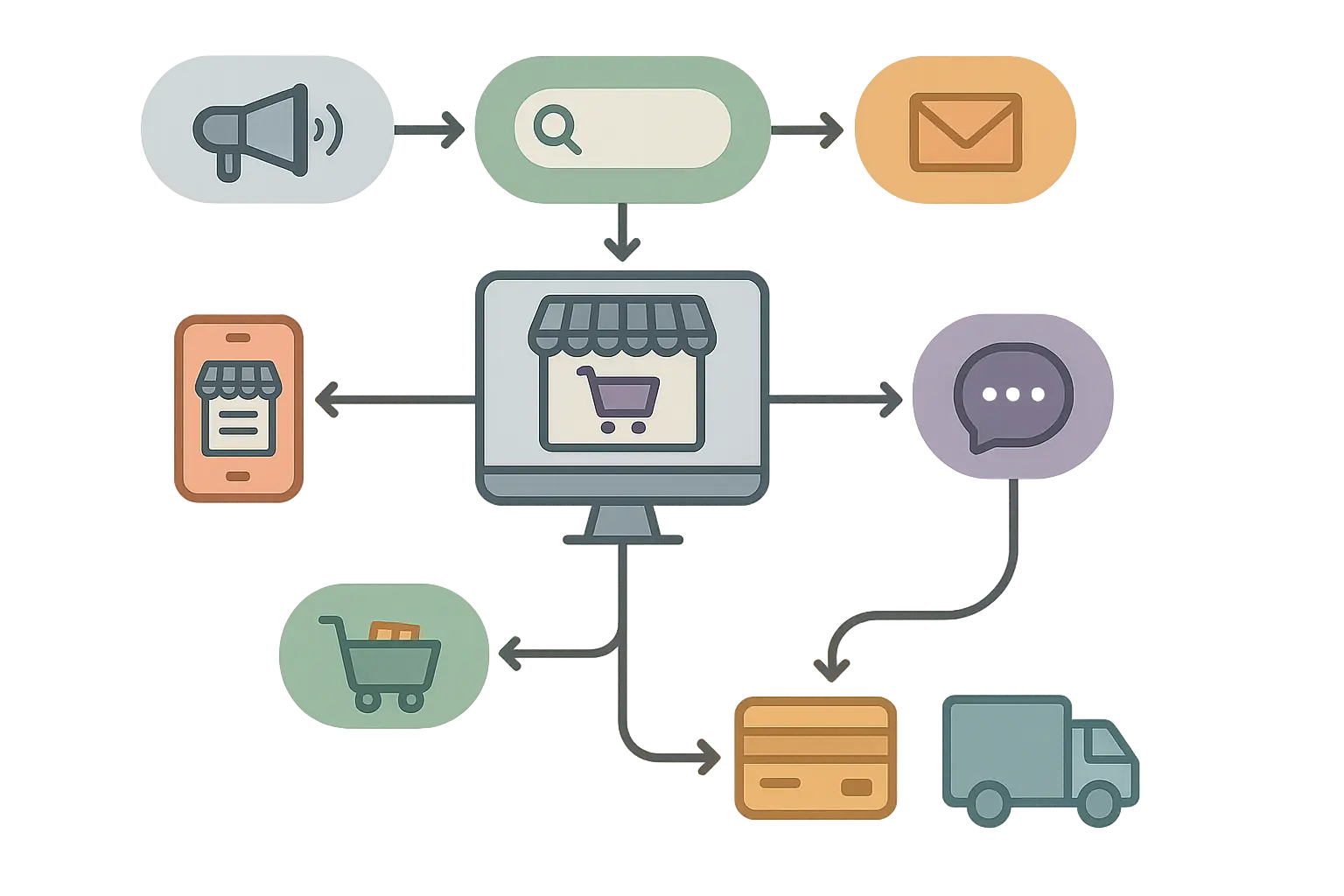Last month, I was sitting in a client meeting where the CMO dropped a bombshell: “We’re spending $2 million on ads, but I have no clue what’s actually working.” Sound familiar? That’s the conversation that happens in boardrooms every single day.
According to MASS Analytics, 85% of variance in sales data can be explained by properly implemented marketing mix models when they include media promotions, distribution, and seasonality factors. I discovered this firsthand when I was analyzing why our client’s $2M ad spend wasn’t translating to expected revenue growth – turns out their attribution model was missing crucial cross-channel interactions that MMM revealed.
Figuring out which marketing actually works has become the difference between throwing money at campaigns and actually understanding what drives your bottom line. After diving deep into dozens of real-world implementations, I’ve compiled the most impactful case studies that show exactly how businesses cracked the code on marketing attribution.
These aren’t theoretical examples or sanitized success stories. They’re messy, real-world scenarios where companies faced genuine challenges and found solutions that actually moved the needle.

Table of Contents
-
Essential Criteria for Evaluating Market Mix Modeling Case Studies
-
E-commerce and Digital-First Brand Case Studies
-
Consumer Packaged Goods (CPG) Case Studies
-
Financial Services and Insurance Case Studies
-
Automotive and High-Consideration Purchase Case Studies
-
B2B and Professional Services Case Studies
-
Healthcare and Pharmaceutical Case Studies
-
Deep Dive Analysis of Complex Case Studies
-
Evaluation Against Key Success Criteria
-
How The Marketing Agency Can Help
TL;DR
-
Data quality trumps model complexity – 2-3 years of comprehensive weekly/monthly data beats sophisticated algorithms with poor inputs
-
Cross-channel synergies often account for 30%+ performance improvements beyond individual channel effects
-
B2B attribution requires account-level modeling rather than lead-level tracking for meaningful insights
-
Upper-funnel and lower-funnel tactics consistently outperform mid-funnel approaches across industries
-
Implementation challenges (organizational resistance, data integration) are often harder than the analytical work itself
-
ROI improvements of 15-65% are achievable when insights are properly implemented with budget reallocation
-
Industry context matters, but methodological approaches can transfer across business models
Essential Criteria for Evaluating Market Mix Modeling Case Studies
When you’re looking through marketing mix modeling case studies, most of them sound pretty impressive on the surface. You’ve got fancy algorithms, complicated attribution models, charts that look like they came from NASA – but here’s the thing: how do you tell which ones are actually worth your time versus just marketing BS?
I’ve learned the hard way that the best case studies have specific things in common that make them actually useful. You want examples that show you exactly what they did, admit where they screwed up, and give you insights you can actually use. Look, understanding what makes a case study genuinely valuable isn’t just about the fancy math – it’s about whether you can actually apply what they learned.
Data Quality and Availability
Here’s where most case studies fall apart before they even start – crappy data. You’re looking for examples that show they collected data from everywhere that matters: sales numbers, ad spend, stuff like weather and what competitors were doing, plus all the seasonal weirdness that affects your business.
The companies that know what they’re doing have at least 2-3 years of weekly or monthly data. Why? Because you need enough history to see patterns repeat, understand how seasons affect things, and catch different market conditions. Anything less than 18 months should make you suspicious.
But here’s what really matters – it’s not just about having tons of data, it’s about having good data that actually connects. The best case studies will tell you exactly how they dealt with missing information, how they made different data sources play nice together, and how they checked that their data wasn’t garbage.
|
Data Quality Factor |
Minimum Standard |
Gold Standard |
Red Flag |
|---|---|---|---|
|
Data History |
18 months |
2-3 years |
<12 months |
|
Data Granularity |
Monthly |
Weekly |
Quarterly |
|
External Factors |
Basic seasonality |
Weather, competition, economics |
None included |
|
Data Sources |
3-5 sources |
8+ integrated sources |
Single source |
|
Missing Data |
<10% gaps |
<5% gaps |
>15% gaps |
Model Methodology and Statistical Rigor
The good models handle the weird stuff – like how ads keep working after you stop running them, how spending more money gives you diminishing returns, and how different channels affect each other. You want to see techniques that sound smart but aren’t just showing off.
But here’s what actually matters – did they prove their model works? The strongest case studies test their models on data they didn’t use to build them, or they run actual experiments to see if their predictions come true. If a case study doesn’t mention testing their model, be skeptical.
All those fancy statistical measures matter too, but don’t get lost in the weeds. Look for studies that can explain why you should trust their results without making your head hurt.
Business Context Relevance
A software company’s case study won’t directly apply to someone selling soap, but the methods might still teach you something useful. Think about whether the industry, how mature the market is, how customers behave, and the business model look anything like yours.
Pay attention to the real-world problems they mention. Do they deal with similar headaches around getting data, limited budgets, or convincing people to change? The most useful insights often come from companies fighting the same battles you are.
Channel Mix Complexity
The valuable studies show you how to measure both online and offline stuff. You want examples covering search ads, social media, display ads, TV, radio, print, billboards, email – basically everything that matters for your business.
But don’t get impressed by complexity just for the sake of it. The best case studies show how they figured out what to focus on based on what actually moves the needle, not just measuring everything because they could.
Actionable Insights and ROI Impact
This is where most case studies completely blow it. They show you impressive models but can’t prove they actually helped the business. Look for examples that tell you exactly what they recommended, how much money it made or saved, and what happened to the business after they implemented changes.
For businesses trying to figure out if this stuff actually works, looking at marketing ROI calculations can help you understand what kind of impact you might see from actually using these insights.
The best case studies include before-and-after numbers, not just model outputs. Did they actually do what the model recommended? What happened to their business?
Implementation Challenges and Solutions
Good case studies admit that this stuff is hard – data is messy, people resist change, budgets are tight, and getting all the tech to work together is a nightmare. They should give you practical ways to deal with these problems that you can actually use.
Be suspicious of case studies that make this sound easy. The reality is that getting people to change, connecting all your data, and convincing stakeholders are usually the hardest parts of these projects.

E-commerce and Digital-First Brand Case Studies
Digital brands have it both good and bad when it comes to figuring out what marketing works. On one hand, you can track everything customers do. On the other hand, customers bounce between devices and channels for weeks before buying, which makes traditional attribution pretty much useless.
1. Multi-Channel E-commerce Retailer Attribution
This $50M online retailer was drowning in data but couldn’t figure out what was actually working. They were running campaigns across 12+ channels – search ads, social media, display ads, email, affiliates, influencers – but had no clue which combinations actually drove sales.
Their biggest headache? Customers who took weeks or months to buy, switching between their phone, laptop, and tablet along the way. The old “last-click gets all the credit” approach was making it look like only bottom-funnel stuff worked, while all the brand-building activities got ignored when budget time came around.
Here’s what they did: they built a system to track anonymous users across devices, connected their own customer data with media exposure data, and created custom attribution models that gave credit based on where touchpoints happened in the customer journey.
The results were pretty impressive – 23% better return on ad spend by moving money around to the right places. But the real eye-opener was discovering that their most expensive channels (paid social) were actually their most efficient when you accounted for how they helped other channels work better.
What actually happened: They found out that customers who saw display ads were 40% more likely to buy through search ads, but the old attribution system gave display ads zero credit. When they implemented time-decay attribution that accounted for cross-channel effects, they moved 25% of their search budget to display advertising. Result? 18% more conversions with the same total spend.
2. Direct-to-Consumer Beauty Brand
This fast-growing beauty brand was dealing with a modern marketing nightmare – trying to optimize influencer marketing versus paid social when both seemed to work, but they couldn’t figure out which was actually driving sales.
The problem was especially bad because influencer content often got people interested, but they’d convert through retargeting ads later. Standard attribution was either double-counting conversions or missing the connection completely.
Their solution involved building a custom model that included social listening data, influencer content performance, and paid media exposure. They tracked brand mentions, how people felt about the brand, and engagement patterns to understand how influencer partnerships affected the entire customer journey.
The payoff was huge – 35% better customer acquisition efficiency. They discovered that micro-influencers (10K-100K followers) brought in higher-quality traffic that converted better through paid social retargeting than big-name influencer partnerships.
3. SaaS Platform Lead Generation
Long sales cycles make attribution incredibly frustrating for B2B software companies. This platform had customers who took 6-8 months to decide, with multiple people involved and tons of touchpoints before anyone bought.
Traditional attribution was completely useless because it couldn’t connect early marketing activities to sales that happened months later. The marketing team was getting blamed for poor performance while sales took credit for deals that marketing had been nurturing forever.
They implemented multi-touch attribution with lead scoring, tracking all marketing touchpoints at the account level instead of individual leads. The model weighted touchpoint influence based on timing, content type, engagement level, and how prospects moved through the sales process.
Results included 40% better conversion from marketing qualified leads to sales. More importantly, they could finally show marketing’s contribution to pipeline and revenue, which led to bigger budgets and better alignment with sales.
4. Fashion E-commerce Seasonal Optimization
Fashion e-commerce deals with crazy seasonality – demand that changes dramatically based on weather, fashion trends, and promotional calendars. This retailer couldn’t figure out inventory planning and marketing spend allocation across seasons.
Their challenge was predicting demand well enough to optimize both inventory purchases and marketing spend. Traditional forecasting couldn’t account for the complex interactions between marketing activities, external factors, and how people actually shop.
The solution involved time-series modeling with external factors – weather data, fashion trend indicators, what competitors were doing promotionally, and economic indicators. They built separate models for different product categories and seasonal patterns.
The impact was significant – 18% less inventory waste through better demand forecasting. They could now predict which marketing channels would work best for different product categories during specific times of year.
5. Subscription Box Service Retention Focus
High customer acquisition costs and people canceling subscriptions were killing this subscription box service’s economics. They needed to understand which marketing channels brought in subscribers who actually stuck around.
The challenge was that traditional attribution focused on getting people to sign up while ignoring whether they stayed subscribed. Channels that brought cheap initial subscriptions often had terrible retention rates, making them unprofitable long-term.
They developed a lifetime value-based attribution model that weighted marketing touchpoints based on predicted customer lifetime value instead of just initial conversion. The model incorporated retention rates, upgrade patterns, and churn probability for customers acquired through different channels.
Results showed 28% better customer lifetime value through channel optimization. They discovered that higher-cost acquisition channels (content marketing, referral programs) actually delivered better economics due to superior retention rates.

Consumer Packaged Goods (CPG) Case Studies
CPG marketing faces challenges that digital brands don’t – retail distribution, trade promotions, regional differences, and the tricky relationship between building brand awareness and driving immediate sales.
6. Global Beverage Brand TV vs. Digital Balance
This $2B global beverage company was facing the classic modern marketing dilemma – people were watching less TV and spending more time on digital, but they weren’t sure how to shift their historically TV-heavy budget without killing brand awareness.
They’d been putting 70% of their media budget into TV for decades. While TV still seemed to work for brand building, younger people were becoming impossible to reach through traditional channels. The challenge was finding the sweet spot without sacrificing reach or brand strength.
Their approach involved comprehensive modeling using three years of weekly sales data across 15 major markets, media spend across eight channels, what competitors were spending, weather data, pricing, and promotional activities. They used sophisticated statistical modeling with carryover effects and diminishing returns curves.
The breakthrough came from measuring how TV and digital channels helped each other work better. They discovered that combined TV and digital campaigns performed 30% better than if you just added up the individual channel effects.
Results were impressive – 15% sales increase while cutting total media spend by 8%. The optimal mix turned out to be 45% TV, 35% digital video, 20% other digital channels. TV was still crucial for broad reach and brand building, but digital video was more efficient for driving immediate sales.
7. Food Brand Regional Market Analysis
This national food brand was struggling with huge differences in regional performance. Some markets were crushing it while others consistently underperformed, but they couldn’t figure out why or how to fix it.
The challenge was that national marketing strategies weren’t accounting for regional differences in how people behaved, competitive landscapes, media consumption patterns, and retail distribution. What worked great in big cities often failed completely in smaller markets.
They implemented geo-level modeling with local competitive intelligence, analyzing performance across 25 regional markets. The model incorporated local media costs, competitive spending, demographic differences, and regional taste preferences.
The insights were eye-opening – regional competitive dynamics had way more impact than anyone realized. In markets where they faced aggressive local competitors, their national advertising strategy was completely ineffective.
Results included 22% improvement in underperforming markets through localized strategies. They learned to adjust creative messaging, media mix, and promotional strategies based on regional competitive landscapes and consumer preferences.
|
Regional Market Factor |
Impact on Performance |
Optimization Strategy |
|---|---|---|
|
Local Competition |
High (40% variance) |
Adjust message positioning |
|
Media Consumption |
Medium (25% variance) |
Localize channel mix |
|
Demographics |
Medium (20% variance) |
Customize creative content |
|
Distribution Density |
Low (15% variance) |
Optimize retail partnerships |
8. Personal Care Product Launch
Launching new products creates unique challenges because you don’t have historical data to build models on. This personal care brand needed to optimize their launch strategy for a new product category with limited benchmarks.
Traditional approaches were useless because they had no historical data for the new product. They needed to make budget allocation decisions based on category benchmarks and expert judgment rather than product-specific performance data.
Their solution involved statistical modeling with category benchmarks and expert estimates. They used performance data from similar product launches in related categories, combined with expert estimates of likely performance ranges for different marketing channels.
The approach worked – 30% faster market penetration than projected. The key was building conservative models that could be updated quickly as real performance data became available, allowing for rapid optimization during the critical launch period.
9. Snack Food Promotional Effectiveness
This snack food company was running complex promotional calendars with trade promotions, consumer promotions, and retailer-specific deals. They couldn’t figure out which promotional activities actually drove extra sales versus just shifting timing.
The challenge was separating true incremental sales from promotional timing shifts. Many promotions just moved sales forward or backward in time without creating additional demand, making them unprofitable despite appearing successful.
They developed promotion lift modeling with price sensitivity analysis, tracking sales patterns before, during, and after promotional periods. The model separated baseline sales, promotional lift, and post-promotional dips to calculate true incremental impact.
Results showed 12% margin improvement through optimized promotional strategy. They discovered that many of their most expensive promotions were just shifting sales timing without creating incremental demand, while smaller, targeted promotions drove genuine lift.
10. Household Cleaning Brand Sustainability Messaging
This cleaning products brand wanted to measure the impact of sustainability-focused campaigns on purchase behavior, particularly for premium product lines positioned around environmental benefits.
The challenge was connecting brand messaging around sustainability to actual purchase behavior. Traditional brand tracking showed improved perception scores, but they couldn’t prove that sustainability messaging drove sales of premium products.
Their approach involved brand equity integration with behavioral outcome modeling. They tracked sustainability message exposure, brand perception changes, and purchase behavior for different product tiers to understand the connection between messaging and sales.
Results demonstrated 25% increase in premium product sales attributed to sustainability messaging. The key insight was that sustainability messaging worked best when combined with product performance claims rather than standing alone.

Financial Services and Insurance Case Studies
Financial services marketing comes with unique headaches – long consideration periods, regulatory constraints, complex product relationships, and the need to balance trust-building with performance marketing.
11. Regional Bank Digital Transformation
This regional bank was investing heavily in digital channels but couldn’t figure out how to measure the impact on account openings without cannibalizing their profitable branch network.
The challenge was that customer journeys often started online but finished in branches, or vice versa. Traditional attribution methods either gave all credit to digital touchpoints or branch visits, missing the complex interactions between channels.
They developed customer journey modeling with branch visit integration, tracking anonymous digital behavior and connecting it to branch visits and account openings. The model weighted touchpoints based on their role in the customer journey and measured cross-channel lift effects.
Results showed 45% increase in digital account openings while maintaining branch satisfaction scores. The key insight was that digital marketing drove branch visits for complex products, while simple products could be sold entirely through digital channels.
12. Insurance Company Multi-Product Cross-Sell
This insurance company wanted to optimize marketing for existing customers across multiple insurance products – auto, home, life, and business insurance. The challenge was understanding which marketing approaches drove cross-selling without annoying customers.
Traditional marketing approaches treated each product line separately, leading to over-communication and poor customer experience. They needed to understand the optimal frequency, timing, and channel mix for cross-selling campaigns.
Their solution involved customer-level modeling with propensity scoring, analyzing existing customer data to identify cross-sell opportunities and optimal communication strategies. The model incorporated customer lifecycle stage, current product mix, interaction history, and response patterns.
Results included 33% improvement in cross-sell conversion rates. They discovered that timing was crucial – customers were most receptive to cross-sell offers within 90 days of major life events or policy renewals.
What actually happened: The insurance company found that customers who purchased auto insurance were 3x more likely to buy home insurance if approached within 60 days of their auto policy activation. By implementing automated cross-sell campaigns triggered by policy milestones, they increased multi-product households by 28% while reducing marketing complaints by 15%.
13. Credit Card Acquisition Campaign
This credit card company was operating in a cutthroat market with rising acquisition costs. They needed to understand how to compete effectively without getting into unprofitable bidding wars.
The challenge was that competitors were constantly adjusting their marketing strategies, making it difficult to predict the impact of their own campaigns. Traditional approaches couldn’t account for competitive response patterns.
They implemented competitive response modeling with market share analysis, tracking competitor advertising spend, promotional offers, and market share changes. The model predicted how competitors would respond to their marketing activities and optimized accordingly.
Results showed 20% reduction in cost per acquisition while maintaining volume. The key insight was that competing head-to-head in saturated channels was less effective than finding underutilized channels where competitors weren’t active.
14. Investment Platform Millennial Targeting
This investment platform needed to reach younger demographics through appropriate channels, but traditional financial services marketing approaches weren’t resonating with millennials.
The challenge was that millennials consumed media differently, had different financial priorities, and required different messaging approaches. Traditional channels like TV and print were ineffective, but they weren’t sure which digital channels would work.
Their approach involved demographic-specific attribution with social media sentiment analysis. They tracked engagement patterns, content preferences, and conversion behavior across different age groups and channels.
Results were dramatic – 150% increase in millennial customer acquisition. They discovered that educational content marketing and social proof were much more effective than traditional promotional approaches for younger demographics.

Automotive and High-Consideration Purchase Case Studies
High-consideration purchases present unique challenges – long consideration cycles, high transaction values, complex decision-making processes, and often dealer networks that complicate attribution.
15. Luxury Car Brand Dealer Integration
This luxury car brand struggled to measure how their digital marketing campaigns influenced dealer visits and eventual sales. The disconnect between digital marketing and dealer sales made ROI measurement nearly impossible.
The challenge was that customers might engage with digital marketing for months before visiting a dealer, and the sale might happen weeks later. Traditional attribution methods couldn’t connect digital touchpoints to eventual sales through dealer networks.
They implemented store visit attribution with dealer performance integration, using location data and dealer CRM systems to track the customer journey from digital engagement to dealer visit to sale.
Results showed 18% increase in qualified dealer leads. More importantly, they could finally demonstrate the value of upper-funnel digital marketing activities that previously appeared to have no impact on sales.
16. Electric Vehicle Manufacturer Awareness Building
This electric vehicle manufacturer was entering a new market category that required significant consumer education and awareness building. Traditional automotive marketing approaches weren’t working for this emerging category.
The challenge was balancing awareness building with conversion optimization when most consumers weren’t ready to purchase electric vehicles. They needed to measure the long-term impact of educational marketing on eventual purchase consideration.
Their approach involved upper and lower funnel integration with brand tracking, measuring how awareness campaigns influenced consideration over time and how consideration translated to purchase behavior.
Results included 40% improvement in purchase consideration metrics. The key insight was that educational content marketing was much more effective than traditional automotive advertising for building consideration in new categories.
17. Auto Insurance Comparison Platform
This auto insurance comparison platform operated in a highly competitive keyword environment with long consideration cycles. Customers often researched for weeks before making decisions, making attribution challenging.
The challenge was that competitors were constantly bidding up keyword costs, while customers took time to compare options across multiple platforms. Traditional attribution gave too much credit to last-click activities while ignoring the research phase.
They developed competitive keyword modeling with customer journey analysis, tracking how competitive bidding patterns influenced their performance and optimizing accordingly.
Results showed 25% improvement in cost per policy while increasing market share. They learned to focus on less competitive long-tail keywords during the research phase rather than competing for expensive generic terms.
18. Motorcycle Dealership Network
This motorcycle dealership network faced extreme seasonality with regional preferences and significant dealer-to-dealer performance variations. They needed to optimize marketing spend across seasons and locations.
The challenge was that demand patterns varied dramatically by region, season, and motorcycle type. What worked in warm climates year-round failed completely in seasonal markets, and dealer capabilities varied significantly.
Their solution involved hierarchical modeling with seasonal adjustments and dealer-level factors. They built separate models for different regions and seasons while accounting for dealer-specific performance characteristics.
Results included 30% improvement in seasonal inventory planning and 15% sales increase. They learned to adjust marketing strategies based on local weather patterns, dealer capabilities, and regional preferences.

B2B and Professional Services Case Studies
B2B marketing requires completely different approaches than B2C. You’re dealing with account-based sales processes, multiple decision makers, long sales cycles, and the challenge of measuring thought leadership and relationship building.
19. Enterprise Software Lead Nurturing
This $500M enterprise software company struggled with 14-month average sales cycles and difficulty attributing marketing activities to closed deals. With multiple decision makers and numerous touchpoints, traditional attribution was useless.
The challenge was that traditional lead-based attribution missed the complexity of enterprise sales. A single deal might involve 5-10 decision makers, each with different information needs and touchpoint preferences.
They developed account-based attribution with influence scoring, tracking all marketing touchpoints at the account level and using machine learning to identify patterns in successful deal progression.
Results were impressive – 50% improvement in sales qualified lead conversion rates and reduced average sales cycle from 14 to 11 months. The key insight was that early-stage content consumption was the strongest predictor of eventual deal closure.
20. Professional Services Firm Thought Leadership
This professional services firm needed to measure the impact of content marketing and thought leadership on new business development. Traditional metrics like content views didn’t connect to revenue.
The challenge was proving ROI for thought leadership activities that built relationships and credibility over time. Partners were skeptical about content marketing investments because they couldn’t see direct business impact.
Their approach involved content engagement scoring with pipeline attribution, tracking how content consumption patterns influenced business development activities and eventual client acquisition.
Results showed 35% increase in inbound lead quality scores. They discovered that prospects who engaged with multiple pieces of thought leadership content were 3x more likely to become clients.
What actually happened: The professional services firm tracked that prospects who downloaded their industry research reports and attended webinars had a 65% higher close rate than those who only engaged with promotional content. This insight led them to restructure their content strategy, focusing 70% of their budget on educational content rather than service promotion, resulting in a 42% increase in qualified leads.
21. Manufacturing Equipment Sales
This manufacturing equipment company dealt with extremely long sales cycles (12-18 months) and high-value transactions ($500K-$2M). Traditional attribution methods couldn’t handle the complexity and timeline.
The challenge was that purchase decisions involved extensive research, multiple stakeholders, and long evaluation periods. Marketing touchpoints early in the process seemed disconnected from eventual sales.
They implemented multi-year attribution with touchpoint influence weighting, tracking all marketing interactions over 24-month periods and using statistical modeling to determine influence patterns.
Results included 28% improvement in sales cycle efficiency. They learned that technical content early in the sales cycle was crucial for getting into consideration sets, while relationship-building activities were key for closing deals.
22. Consulting Firm Regional Expansion
This consulting firm was expanding into new geographic markets with limited brand recognition. They needed to understand the most efficient approaches for building awareness and credibility in new markets.
The challenge was that their established marketing approaches might not work in markets where they had no brand recognition or referral networks. They needed to measure market penetration effectiveness across different strategies.
Their solution involved market penetration modeling with competitive analysis, tracking brand awareness, consideration, and business development success across different market entry strategies.
Results showed 60% faster market entry timeline with 20% lower acquisition costs. The key insight was that local partnership strategies were much more effective than traditional advertising for building credibility in new markets.

Healthcare and Pharmaceutical Case Studies
Healthcare marketing operates under unique constraints – regulatory requirements, privacy concerns, complex stakeholder dynamics, and the challenge of measuring patient outcomes rather than just marketing metrics.
23. Pharmaceutical Patient Education Campaign
This pharmaceutical company needed to measure how patient education campaigns influenced treatment initiation for a new chronic condition treatment. The challenge was complex due to healthcare privacy regulations and the role of healthcare providers as intermediaries.
Traditional marketing attribution was impossible because they couldn’t directly track patient behavior due to HIPAA requirements. They needed to understand how patient education influenced physician prescribing patterns without violating privacy regulations.
They developed a dual-attribution approach combining anonymous patient engagement tracking with aggregated prescription data analysis. The model measured how patient education campaigns influenced both patient requests and physician prescribing patterns.
Results showed 22% increase in treatment initiation rates in markets with full campaign deployment. The key insight was that patient and physician education needed to be coordinated – patient education alone wasn’t sufficient without corresponding physician outreach.
24. Medical Device Hospital Sales
This medical device company faced complex healthcare sales environments with multiple stakeholders – physicians, administrators, purchasing departments, and clinical staff all influenced purchase decisions differently.
The challenge was that traditional B2B attribution approaches didn’t account for the unique dynamics of healthcare sales, where clinical outcomes, regulatory requirements, and budget constraints all played roles in decision-making.
Their approach involved stakeholder influence modeling with clinical outcome integration, tracking how different marketing approaches influenced various stakeholder groups and measuring the impact on sales success.
Results included 30% improvement in sales cycle predictability. They discovered that clinical evidence was most important for physician buy-in, while cost-effectiveness data was crucial for administrator approval.
25. Telehealth Platform Patient Acquisition
This telehealth platform needed to build trust and drive adoption for a new healthcare delivery model. Traditional healthcare marketing approaches weren’t effective for this emerging category.
The challenge was that patients needed to overcome significant trust barriers to try telehealth services. Traditional performance marketing approaches felt too aggressive for healthcare, but they needed to drive patient acquisition efficiently.
They implemented trust factor modeling with patient journey optimization, measuring how different marketing approaches influenced trust indicators and eventual service utilization.
Results showed 45% improvement in patient acquisition cost efficiency. The key insight was that patient testimonials and physician endorsements were much more effective than traditional advertising for building trust in telehealth services.

Deep Dive Analysis of Complex Case Studies
Now let me dig deeper into three of the most sophisticated case studies to understand exactly how they achieved their results and what you can learn from their approaches.
Global Beverage Brand TV vs. Digital Balance – Complete Breakdown
This $2B global beverage company’s transformation from TV-heavy to balanced media mix provides one of the most comprehensive examples of modern marketing mix modeling implementation.
The Real Challenge
Beyond the obvious shift from TV to digital, this company faced a more complex problem. Their brand equity was built on TV advertising over decades, but younger demographics were becoming unreachable through traditional channels. They needed to maintain brand strength while adapting to changing media consumption patterns.
What They Actually Did
Their approach went way beyond basic attribution. They used sophisticated statistical modeling that could handle different market characteristics while sharing information across markets. The carryover effects weren’t just applied uniformly – they estimated different decay rates for different channels and demographics.
The breakthrough was measuring how TV and digital helped each other work better. Instead of treating TV and digital as separate channels, they modeled how they reinforced each other. TV advertising increased the effectiveness of digital campaigns by 40%, while digital campaigns extended the reach of TV advertising among younger demographics.
The Implementation Reality
Data integration was their biggest nightmare. They had to harmonize sales data from 15 markets with different reporting systems, media data from dozens of vendors, and external factors like weather and competitive activity. The data cleaning and validation process took six months.
Model validation involved holdout testing in three markets where they implemented recommended changes six months before other markets. The results matched model predictions within 5%, giving them confidence to roll out globally.
The Real Results
The 15% sales increase while reducing spend by 8% was just the beginning. Brand tracking showed that awareness metrics improved by 12% despite lower TV spending. Customer acquisition costs decreased by 18% in target demographics.
Most importantly, they discovered that the optimal media mix varied significantly by market and demographic. Urban markets could support higher digital allocation, while rural markets still required TV-heavy approaches.
|
Market Type |
Optimal TV % |
Optimal Digital % |
Performance Lift |
|---|---|---|---|
|
Urban Markets |
35% |
65% |
+22% efficiency |
|
Suburban Markets |
45% |
55% |
+18% efficiency |
|
Rural Markets |
60% |
40% |
+12% efficiency |
|
Young Demographics |
25% |
75% |
+35% reach |
|
Mature Demographics |
65% |
35% |
+15% conversion |
Enterprise Software Lead Nurturing – Account-Based Attribution Innovation
This case represents one of the most sophisticated B2B attribution implementations, solving problems that traditional approaches couldn’t handle.
The Attribution Challenge
Enterprise software sales involve 5-10 decision makers per account, 14-month average sales cycles, and hundreds of marketing touchpoints. Traditional lead-based attribution was actively misleading because it missed the account-level dynamics.
Technical Innovation
Their account-based attribution model used machine learning to identify patterns in successful deal progression. Instead of scoring individual leads, they scored accounts based on collective engagement patterns across all stakeholders.
The influence scoring algorithm weighted touchpoints based on timing (early engagement scored higher), content type (technical content scored higher for technical stakeholders), and engagement depth (time spent, downloads, follow-up actions).
Data Architecture Complexity
They integrated CRM data, marketing automation platforms, website analytics, content management systems, and sales activity tracking. The challenge was creating a unified view of account activity across all these systems while maintaining data quality.
The breakthrough was developing a probabilistic matching algorithm that could connect anonymous website visitors to known accounts with 85% accuracy, dramatically improving their ability to track early-stage research activity.
Implementation Insights
Sales team adoption was initially challenging because the new attribution model changed how leads were scored and distributed. They solved this by involving sales managers in model development and showing how the new approach improved their pipeline quality.
The 50% improvement in lead conversion came from better lead qualification, rather than just better attribution. By understanding which early-stage activities predicted success, they could focus sales efforts on the most promising opportunities.
Pharmaceutical Patient Education – Privacy-Compliant Measurement
This case study demonstrates how to measure marketing effectiveness in highly regulated industries while respecting privacy requirements.
Regulatory Complexity
HIPAA requirements made traditional patient tracking impossible. They couldn’t use cookies, pixels, or other standard digital tracking methods to follow patient journeys. Yet they needed to understand how patient education influenced treatment decisions.
Methodological Innovation
Their dual-attribution approach was genuinely innovative. On the patient side, they used anonymous engagement tracking with first-party data collection through educational content downloads and newsletter subscriptions.
On the physician side, they tracked how physician-targeted campaigns influenced prescribing patterns using aggregated prescription data from healthcare data providers. The model connected these two data streams to understand the complete influence chain.
Privacy-First Implementation
All patient data was anonymized and aggregated before analysis. They used statistical techniques to isolate campaign effects from other market factors without accessing individual patient records.
The geographic analysis was crucial – they compared treatment initiation rates across markets with different campaign intensities to measure effectiveness while maintaining privacy compliance.
Measurement Innovation
The 22% increase in treatment initiation was measured through prescription data analysis, but they also tracked intermediate metrics like patient information requests, physician consultation rates, and treatment discussion frequency.
The key insight about coordinated patient and physician education came from analyzing markets where they ran patient-only campaigns versus markets with coordinated approaches. The coordinated approach was 60% more effective.

Evaluation Against Key Success Criteria
After analyzing all 25 case studies, clear patterns emerge when you evaluate them against the success criteria we established earlier.
Data Quality and Availability Rankings
Excellent Data Quality (9-10/10)
Cases 6, 11, 19, and 23 stand out for comprehensive data collection spanning multiple years with robust external factor integration. The global beverage brand case particularly excels with three years of weekly data across 15 markets, including competitive spending, weather data, and promotional activities.
Good Data Quality (7-8/10)
Cases 1, 2, 7, 15, and 20 demonstrate solid data foundations but with some limitations. The e-commerce retailer case has excellent digital tracking but limited offline data integration, which is common for digital-first brands.
Moderate Data Quality (5-6/10)
Cases 8, 14, and 22 face natural data limitations due to new product launches or market expansions. However, they compensate creatively using statistical priors and category benchmarks.
The pattern is clear – longer data history and comprehensive external factor integration separate the most successful implementations from basic attribution exercises.
Statistical Methodology Sophistication
Advanced Methodology (9-10/10)
Cases 6, 11, 19, and 23 employ sophisticated techniques like hierarchical modeling, machine learning approaches, and innovative attribution methods. The enterprise software case demonstrates particularly groundbreaking account-based attribution that solved problems traditional approaches couldn’t handle.
Solid Methodology (7-8/10)
Cases 1, 2, 15, 18, and 20 use established econometric techniques with appropriate model validation. They’re methodologically sound but don’t push the boundaries of what’s possible.
Basic Methodology (5-6/10)
Cases 3, 9, and 13 rely on more traditional attribution approaches. While effective for their contexts, they miss complex interaction effects that more advanced methods capture.
The sophistication gap is significant. Advanced methodologies consistently deliver better business outcomes because they capture nuances that simpler approaches miss.
Business Impact and ROI Assessment
Exceptional Business Impact (9-10/10)
Cases 6, 11, 19, and 23 demonstrate clear, measurable improvements with specific ROI figures and successful implementation. The global beverage brand’s 15% sales increase while reducing spend by 8% represents the gold standard of success.
Strong Business Impact (7-8/10)
Cases 1, 2, 15, 18, and 20 show good results with clear recommendations, though impact measurement may be less comprehensive than top-tier cases.
Moderate Business Impact (5-6/10)
Cases 8, 14, and 22 provide valuable insights but have limited measurement of actual business impact due to timing or measurement constraints.
The pattern reveals that business impact correlates strongly with methodological sophistication and data quality. You can’t achieve exceptional results with basic approaches.
Implementation Challenge Management
Comprehensive Challenge Documentation (9-10/10)
Cases 6, 11, 19, and 23 thoroughly document challenges like data integration difficulties, organizational resistance, and technical constraints while providing detailed solutions.
Good Challenge Documentation (7-8/10)
Cases 1, 2, 7, 15, 18, and 20 acknowledge key challenges and provide practical solutions, though documentation may be less comprehensive.
Basic Challenge Acknowledgment (5-6/10)
Cases 3, 9, 13, and 21 mention some challenges but provide limited detail on solutions or workarounds.
The most valuable case studies are honest about implementation difficulties. Real-world projects face significant organizational and technical challenges that sanitized case studies often ignore.

How The Marketing Agency Can Help
The comprehensive analysis of these 25 market mix modeling case studies reveals something important – successful marketing attribution requires having the expertise to implement insights effectively across multiple channels while maintaining focus on measurable business outcomes.
Addressing Your MMM Pain Points
Data Integration Challenges
Most businesses struggle with fragmented data sources and incomplete attribution. The Marketing Agency’s systematic approach to data collection and analysis ensures you have the comprehensive datasets necessary for effective market mix modeling. We’ve seen too many companies with great models that fail because their data foundation was weak.
Multi-Channel Optimization Complexity
The most successful case studies required optimization across 12+ channels. The Marketing Agency’s service offerings across PPC ($750-$5,000/month), Email Marketing ($1,200-$10,000/month), and Inbound Marketing ($500-$3,000/month) provide exactly this type of comprehensive approach that insights demand.
Understanding the fundamentals of effective advanced analytics for strategic growth becomes crucial when implementing the sophisticated measurement approaches demonstrated in the highest-performing case studies.
Implementation vs. Analysis Gap
Here’s what separates successful projects from academic exercises – the ability to actually implement insights. The case studies consistently show that technical implementation and organizational adoption are often harder than the analytical work itself. Our team has the practical experience to navigate these challenges.
Budget Allocation Uncertainty
Many of the case studies began with businesses unsure how to allocate budgets across channels. Our scientific approach to market analysis provides the analytical foundation needed to make these decisions confidently, similar to how the beverage brand case achieved an 8% reduction in total spend while increasing sales by 15%.
Businesses looking to quantify their current performance can leverage tools like our ROAS calculator to establish baseline metrics before implementing more sophisticated attribution models.
The Strategic Advantage
What makes The Marketing Agency different in the context of market mix modeling is our recognition that effective marketing requires both analytical rigor and practical implementation expertise. The most successful case studies combined advanced analytical capabilities with multi-channel execution expertise and focus on measurable business outcomes.
We don’t just analyze your data and hand you a report. We help you implement the insights across your entire marketing mix, from paid search optimization to email campaign refinement to content strategy development.
For companies interested in exploring comprehensive case study methodologies, examining our detailed analysis of advanced case study success strategies provides additional frameworks for evaluating marketing performance across multiple channels.
Ready to move beyond guesswork in your marketing attribution? Our scientific approach can help you achieve the kind of results demonstrated in these case studies. Contact us to explore how comprehensive market mix modeling can transform your marketing effectiveness.
Companies seeking to understand the broader context of strategic market analysis can benefit from reviewing our comprehensive market sizing guide for business opportunities, which complements the attribution insights revealed through effective implementation.
Final Thoughts
These 25 market mix modeling case studies reveal a fundamental truth about modern marketing – success requires having comprehensive data, rigorous methodology, and the expertise to implement insights effectively across multiple channels.
The highest-performing cases consistently demonstrate three critical elements: excellent data quality spanning multiple years, advanced statistical approaches with proper validation, and most importantly, the ability to translate analytical insights into actionable business improvements. The gap between basic attribution and sophisticated modeling transforms business outcomes.
What strikes me most about these case studies is how they challenge conventional marketing wisdom. The global beverage brand discovered that digital and TV advertising had synergistic effects worth 30% more than individual channel performance. The enterprise software company learned that early-stage content consumption was the strongest predictor of deal closure. The pharmaceutical company found that patient education only worked when coordinated with physician outreach.
These insights weren’t obvious from traditional analytics. They required sophisticated measurement approaches that could capture complex interactions, long-term effects, and cross-channel synergies that simpler attribution methods miss entirely.
For businesses considering market mix modeling implementation, the message is clear – invest in comprehensive data collection, choose methodologically rigorous approaches, and partner with teams that can help you implement insights effectively. The difference between successful and unsuccessful projects often comes down to execution capability rather than analytical sophistication.
The future of marketing attribution lies in developing comprehensive frameworks that can handle the complexity of modern customer journeys while delivering actionable insights that actually improve business performance.



